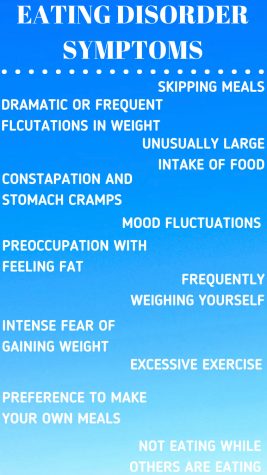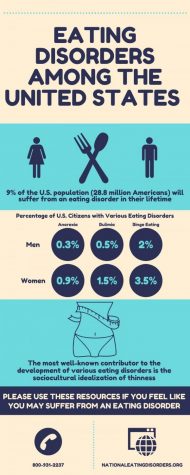What is an eating disorder?
November 10, 2020
Throughout generations, people have struggled with eating disorders, whether it be anorexia, bulimia, binge-eating, restrictive food intake disorder (ARFID), rumination disorder or countless other types of disorders. Unfortunately, in today’s society, social pressures of body image is one of the largest contributors to peoples’ suffering. Though many cannot see it, eating disorders do impact one’s emotional and mental health, rather than solely their physical health.

Most eating disorders are based upon the desire to lose weight whether it be through the act of starving oneself, or purging to then follow-up by vomiting. Most often, eating disorders are developed amongst teenagers and young adults as they are easily manipulated by tabloids, magazines, influencers, and other sources that can make them feel ugly because of their weight.
Today, there are many misconceptions about eating disorders and how they impact one’s life. Just because someone does not look thin, does not mean that they do not suffer from an eating disorder. Just because you see someone eat in front of you, does not mean that they do not suffer. Just because someone tells you that they do not suffer from an eating disorder, does not mean that they do not. Oftentimes, some of the people struggling do not realize how severe their condition has become. It starts off with making healthier lifestyle choices like eating healthier or going to the gym, but quickly thereafter, it can become an obsession for some. People with eating disorders can look at themselves after a long time of dealing with their disorder and very obviously look unhealthy and lacking nutrition, and still see themselves as “fat” and “ugly” in the mirror.
According to the National Institute of Mental Health (NIMH), anorexia nervosa, bulimia nervosa and binge-eating are the most common types of eating disorders. The Mayo Clinic describes anorexia nervosa as occurring in people who show signs of abnormally low body weight and an extreme and constant fear of gaining weight. People struggling with this condition go to extreme lengths to ensure that they stay thin and they do this by starving themselves, calorie counting, and exercising themselves to the point where in some cases, you can find bruises along their spines due to the excessive amount of sit-ups.
Bulimia nervosa is a condition described by the Mayo Clinic in which there is a lack of control over one’s eating that leads to purging, followed up by the act of vomiting to rid oneself of the calories. Bulimia can occur in episodes where one person can purge for hours, and spend a large amount of time thereafter, vomiting and restricting themselves. Contrasting to anorexia where one may appear to be abnormally thinner than the average weight, someone with bulimia may appear to be of average weight or even a bit overweight, making it difficult to look for the common signs.

Binge-eating disorder is defined as an instance in which people often eat excessively, but do not try to compensate for it like in anorexia or bulimia. Instead, one who struggles with this disorder prefers to eat alone, eat when they are not hungry, and continue eating even after they are full. Because one does not try to compensate for their weight in this particular disorder, people who have a binge-eating disorder can be of normal weight, or in most cases, slightly overweight. Though shame and guilt are a large factor of all eating disorders, in a binge-eating disorder especially, these same factors along with embarrassment are intensified and a large contribution in why these people prefer to eat alone.
Eating disorders are never planned, even though one’s intention may have originally been to lose or gain weight. Some causes of eating disorders are natural, like genetics, and others include the individual’s physiological and mental health. Many do not consider that eating disorders are physiologically harmful as well. People suffering from eating disorders usually have an extremely negative mental health prompting depression, anxiety, social problems, any kind of substance abuse and in the worst cases, it can lead to suicidal thoughts. In fact, eating disorders often come along with other mental illnesses like anxiety, OCD, depression and other disorders according to the National Eating Disorders Association (NEDA). Moreover, they stated that ⅔ of people that are diagnosed with an eating disorder like anorexia, showed signs of anxiety several years before their eating disorder started.
The most serious physical complications of eating disorders include damage to the heart, bones, reproduction system (infertility), mouth, jaw and teeth. Some less serious symptoms of eating disorders include swelling in the mouth, brittle hair, yellow or dry skin, loss of energy resulting in dizziness and fainting, feeling cold, stomach pain, weakness and a variety of other things.
Eating disorders, although over time can be treated, are not illnesses that can disappear and never come back. Unfortunately, approximately 35% of people who have undergone treatment for an eating disorder have reported a relapse after their treatment as claimed by the eating recovery center. Understandably, it can be stated that while in some cases, eating disorders may not be a lifelong illness, many people who have suffered in the past from eating disorders are much more likely to have a relapse or redevelop and illness alike even 10 years after their original diagnosis or even treatment.
Notably, people who suffer from eating disorders have a large portion of their life taken up by their own thoughts and eating habits, though it is important to know that eating disorders do not define who someone is. It is merely a part of who they are and what they have gone through and still may be going through. Fortunately, there are many resources available to provide not only short and long term solutions, but tools to ensure people who suffer from these disorders can lead happy and fulfilling lives.